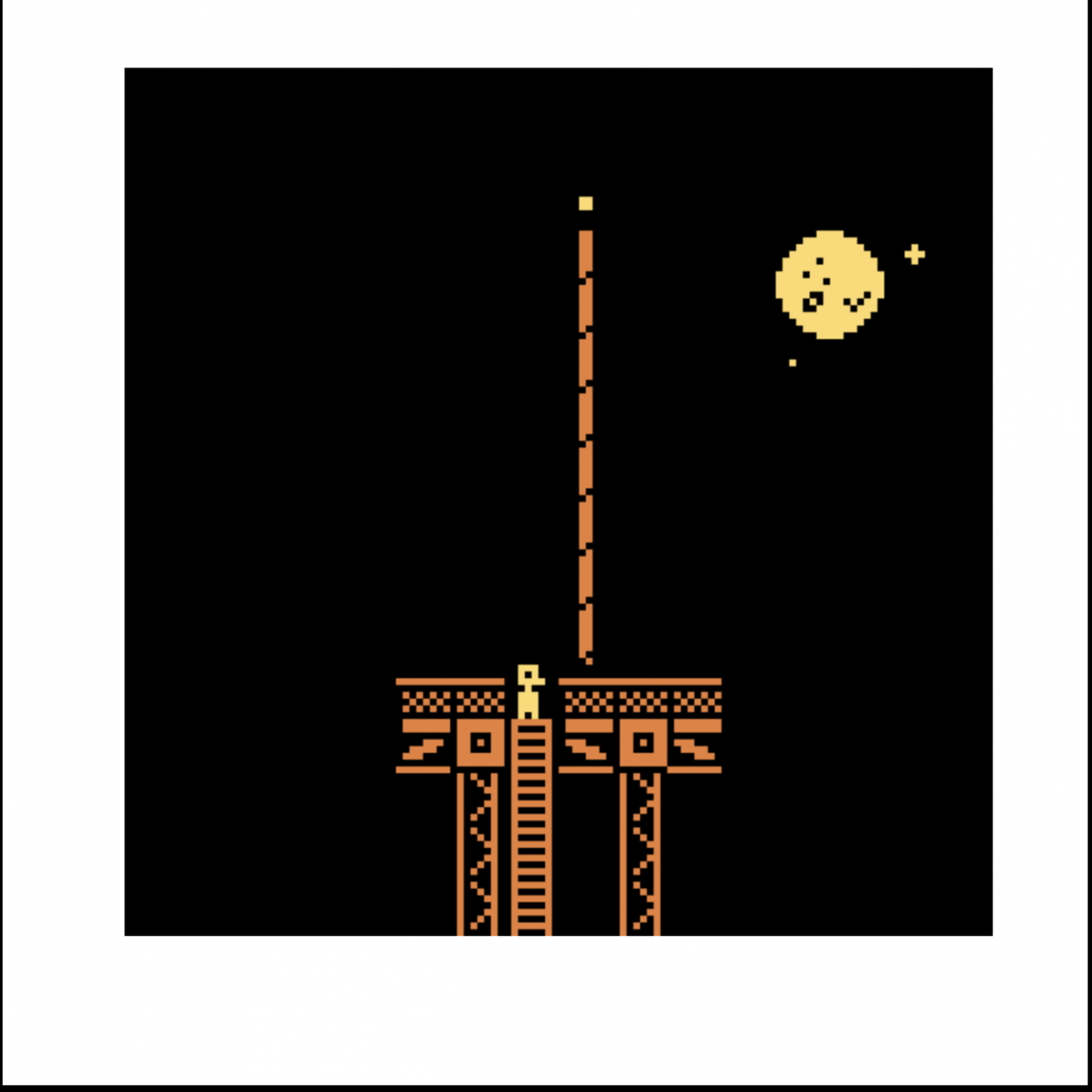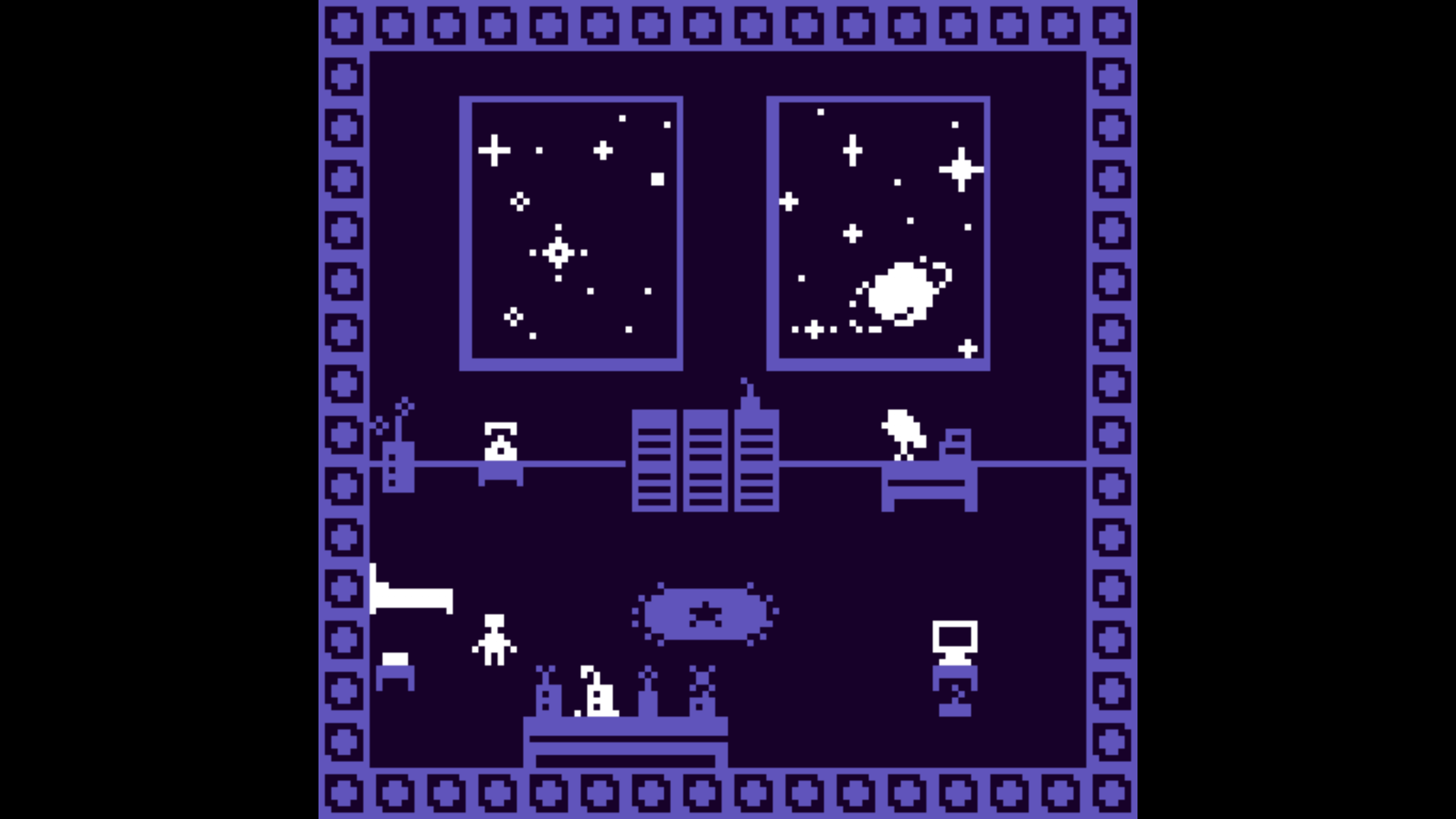An exhibition and online jam celebrate the game engine tool’s ambitiously modest aesthetics
Imagine a video game. Think of what that game might look like, how it might play, how long it might take to fully play through, how dense its content might be, how rich its world might be rendered. And now, strip away all of that. Remove any hi-fi graphics, pare down the game play to the most basic 2D movement and single-button interaction, scale it way back. Does it still feel like a video game?
It should, because that’s exactly what artists and designers are using Bitsy to do. Bitsy is an online tool for making small, often quotidian, two dimensional, 1-bit (i.e., two colour) games. Using the tool requires minimal coding (if at all) and no artistic prowess. Bitsy games harken back to the design of early Nintendo adventure games like The Legend of Zelda (1987): simple graphics, a playable avatar moved with keyboard arrow keys, and a single button for interacting with objects or non-playable characters. These games can have stated goals or even multiple endings, but ‘winning’ isn’t a hard requirement. Once completed they can be easily zipped, uploaded online or embedded on sites like itch.io.
The tool, designed by Adam Le Doux, is celebrating its seventh anniversary this month in collaboration with the online gallery and game-archiving project The Museum of Screens (run by developer and game-maker Toulou Toumou). Bitsy Fest, a semi-regular game jam – an event where designers and hobbyists get together to develop a game from scratch in a (typically) short amount of time – took place between 22 September and 15 October and concluded with an exhibition featuring notable games using Bitsy.

Though Bitsy is certainly a tool, it can be better understood as a community – one fiercely devoted to the tool. Forums are overflowing with add-ons, the Discord server is abuzz with newcomers seeking inspiration. All the while, in its seven years, users have been content with Bitsy remaining rooted in simplicity. The low threshold of technical knowledge especially appealed to artists coming from DIY-arts/music backgrounds interested in making interactive stories but lacking access or resources to develop on other indie game engines. Several developers use it as a sketch pad, or a notebook for workshopping stories and interaction design concepts. Other artists came to Bitsy as an alternative to other online game-making tools like Phaser, and many still arrived at Bitsy’s doorstep in the aftermath of the death of Adobe Flash. Regardless of point-of-entry, the community has been galvanised by the core principles of Bitsy’s charm and lack of pretension which stands in opposition to the industry’s notorious gatekeeping. Game designer Alicia Ripp, who is assisting Toumou and Le Doux with the exhibition and jam, notes that her initial exposure to Bitsy came after noticing queer voices becoming active members within the user base, linking zine-making to Bitsy’s underlying ethos.
Games that utilize the engine best focus on intimate moments of contemplation, quietness and repose. Far from the bombast of their AAA cousins (a shorthand term for mainstream game studios with multimillion dollar budgets and vast labour pools at their disposal, like Call of Duty), Bitsy games celebrate silence – both literally (since the tool doesn’t support audio without a plug-in) and figuratively: there is a hushed tone about Bitsy games, a whisper in the ear, pillow talk murmurs, airy soliloquies. For jam #77 the community chose ‘museum’: a fitting prompt for this year’s celebration. Like previous jams, contributions for this iteration are equally heartfelt and vulnerable. Fishhooks by Ellis Devereux, is one such contribution where you play as a deep sea diver exploring the depths of their own memories.
Previous jam themes – typically are voted on by the community – included ‘the little things’, ‘sleepy’, ‘clouds’, ‘echo’, and ‘daydream’ and produced an abundance of poignant meditations on relationships, regret, grief and (above all) the inner struggles of living in a collapsing world.

Charcoal Pencils by Léo Mirland, for example, explores small memories of childhood trees while creating graphite rubbings from their now felled trunks. G.P. Lackey’s ‘microgame’, The Tower at Night simply asks the player to ascend a series of ladders to witness a breathtaking full moon. In maker caanti’s work i had another dream about you last night, the player walks through a dream concluding in a cosmic figure reassuring you that happiness can come in as many forms as there are stars. For artists and designers, Bitsy’s small scale encourages users to turn the everyday into something previous. A guiding principle shared widely within the Bitsy community is that even a moment of temporary comfort or shared contemplation can be a generous and beautiful act.
But where these works are uplifting in tone, other Bitsy games are more solemn. There Aren’t Really Words… by rose.kiid is a powerful reflection on the difficult immediacy of processing sudden grief. The prolific gamemaker candle has made several Bitsy projects including The Last Days of Our Castle and Forgotten Depths that serve as pixelated memento mori ruminating on loss, the sublime and regret by directly borrowing motifs and language from Romanticism. Cecile Richard’s breathtaking games also reflect on mortality, and Under a Star Called Sun is truly remarkable in its ability to bring tears to a player’s eyes in mere minutes of gameplay. Though still made with the same fundamental frankness as their more whimsical, dreamy counterparts, these games evidence Bitsy’s ability to envision (and enact) moments of collective feeling.
Perhaps the technical limitations of the engine bracket the kinds of experiences designers end up creating. But the community has fostered a discourse around the need for small games to exist, especially as mainstream developers strive for artistic validation (look no further than Tribeca Film Festival hosting Creative Directors from Playstation’s Santa Monica Studio, or Minecraft being collected by MoMA). Bitsy’s insistence on being pocket-sized counters the overwhelming glut of games like the recently released epic sci-fi action-RPG Starfield. By prioritising quaintness and removing the technical barrier of entry often required for game making, Bitsy celebrates smallness, making space for games to be more like a haiku than a blockbuster movie.
Nicholas O’Brien is an artist, writer and game designer based in Brooklyn, NY.
